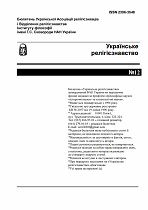Inculturation: movement to national churches or clericalization of national cultures
DOI:
https://doi.org/10.32420/1999.12.1041Abstract
Until recently, the church and culture in the confessional sense could not be equal and equal in size. The partnership of dichotomy church-culture was denied both first and second. The historic church tried to stand over culture, and culture tried to distance itself from the church. The idea of culture was associated with church only with religious culture, which was defined as social reproductive or creative activity of people in the sphere of being and consciousness, which was associated with belief in supernatural. Religious culture has always been denominationally differentiated and expressed the historically reached level of development of religious movements (say: a sect-denomination-church, or a religious community - an institutionalized church institution). Religious culture was distinguished by its features as material (it was based on the religious cult), and the spiritual one (the system of samples, norms of behavior and religious knowledge systematically implanted, fixed by a certain church, as well as the level of mastery by followers of this doctrine).
Downloads
Published
Issue
Section
License
Copyright (c) 1999 © Author of Article

This work is licensed under a Creative Commons Attribution-NonCommercial-ShareAlike 4.0 International License.


